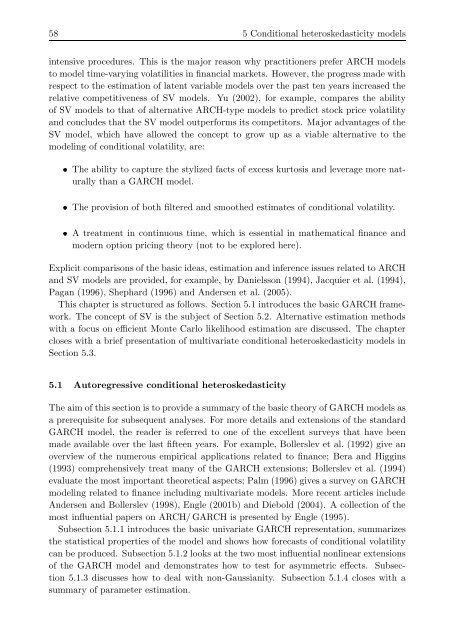Applications of state space models in finance
Applications of state space models in finance
Applications of state space models in finance
You also want an ePaper? Increase the reach of your titles
YUMPU automatically turns print PDFs into web optimized ePapers that Google loves.
58 5 Conditional heteroskedasticity <strong>models</strong><br />
<strong>in</strong>tensive procedures. This is the major reason why practitioners prefer ARCH <strong>models</strong><br />
to model time-vary<strong>in</strong>g volatilities <strong>in</strong> f<strong>in</strong>ancial markets. However, the progress made with<br />
respect to the estimation <strong>of</strong> latent variable <strong>models</strong> over the past ten years <strong>in</strong>creased the<br />
relative competitiveness <strong>of</strong> SV <strong>models</strong>. Yu (2002), for example, compares the ability<br />
<strong>of</strong> SV <strong>models</strong> to that <strong>of</strong> alternative ARCH-type <strong>models</strong> to predict stock price volatility<br />
and concludes that the SV model outperforms its competitors. Major advantages <strong>of</strong> the<br />
SV model, which have allowed the concept to grow up as a viable alternative to the<br />
model<strong>in</strong>g <strong>of</strong> conditional volatility, are:<br />
The ability to capture the stylized facts <strong>of</strong> excess kurtosis and leverage more naturally<br />
than a GARCH model.<br />
The provision <strong>of</strong> both filtered and smoothed estimates <strong>of</strong> conditional volatility.<br />
A treatment <strong>in</strong> cont<strong>in</strong>uous time, which is essential <strong>in</strong> mathematical f<strong>in</strong>ance and<br />
modern option pric<strong>in</strong>g theory (not to be explored here).<br />
Explicit comparisons <strong>of</strong> the basic ideas, estimation and <strong>in</strong>ference issues related to ARCH<br />
and SV <strong>models</strong> are provided, for example, by Danielsson (1994), Jacquier et al. (1994),<br />
Pagan (1996), Shephard (1996) and Andersen et al. (2005).<br />
This chapter is structured as follows. Section 5.1 <strong>in</strong>troduces the basic GARCH framework.<br />
The concept <strong>of</strong> SV is the subject <strong>of</strong> Section 5.2. Alternative estimation methods<br />
with a focus on efficient Monte Carlo likelihood estimation are discussed. The chapter<br />
closes with a brief presentation <strong>of</strong> multivariate conditional heteroskedasticity <strong>models</strong> <strong>in</strong><br />
Section 5.3.<br />
5.1 Autoregressive conditional heteroskedasticity<br />
The aim <strong>of</strong> this section is to provide a summary <strong>of</strong> the basic theory <strong>of</strong> GARCH <strong>models</strong> as<br />
a prerequisite for subsequent analyses. For more details and extensions <strong>of</strong> the standard<br />
GARCH model, the reader is referred to one <strong>of</strong> the excellent surveys that have been<br />
made available over the last fifteen years. For example, Bollerslev et al. (1992) give an<br />
overview <strong>of</strong> the numerous empirical applications related to f<strong>in</strong>ance; Bera and Higg<strong>in</strong>s<br />
(1993) comprehensively treat many <strong>of</strong> the GARCH extensions; Bollerslev et al. (1994)<br />
evaluate the most important theoretical aspects; Palm (1996) gives a survey on GARCH<br />
model<strong>in</strong>g related to f<strong>in</strong>ance <strong>in</strong>clud<strong>in</strong>g multivariate <strong>models</strong>. More recent articles <strong>in</strong>clude<br />
Andersen and Bollerslev (1998), Engle (2001b) and Diebold (2004). A collection <strong>of</strong> the<br />
most <strong>in</strong>fluential papers on ARCH/ GARCH is presented by Engle (1995).<br />
Subsection 5.1.1 <strong>in</strong>troduces the basic univariate GARCH representation, summarizes<br />
the statistical properties <strong>of</strong> the model and shows how forecasts <strong>of</strong> conditional volatility<br />
can be produced. Subsection 5.1.2 looks at the two most <strong>in</strong>fluential nonl<strong>in</strong>ear extensions<br />
<strong>of</strong> the GARCH model and demonstrates how to test for asymmetric effects. Subsection<br />
5.1.3 discusses how to deal with non-Gaussianity. Subsection 5.1.4 closes with a<br />
summary <strong>of</strong> parameter estimation.

















